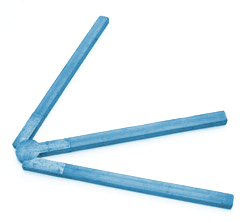
| Drafting |  |
| A Notable Beginning | Click on any image for a larger view. Scroll to view more items. |
|
In Aikin's 1813 General Biography, we read of Ramsdenıs four-year apprenticeship to Mr. Burton, a specialist "...in making thermometers and barometers, and in engraving and dividing mathematical instruments. Not long after the expiration of his apprenticeship, he became a partner with a workman of the name of Cole, under whom he was at first a journeyman, with no higher wages than twelve shillings a week. This partnership, however, did not long continue; and after its dissolution Mr Ramsden opened a workshop on his own account, where he soon recommended himself to employment by some of the most eminent and mathematical instrument makers, particularly Sisson, Dollond, Nairne and Adams. In the course of that employment, his repeated examination of the instruments which were sent to him to be engraven or divided, led him to notice their defects, and his genius suggested to him the means of removing them, or of constructing better instruments." McConnell (2007) |
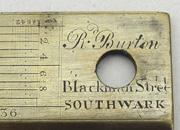 |
|
ARCHITECTURAL / CHARTING RULE BY THE STRUGGLING SON OF RAMSDEN'S MASTER, English, c. 1785, signed "Rd. Burton, Blackman Street, Southwark," the 14" (35.7 cm) brass rule divided on both sides with scales of equal parts (at 1, 2, and 3 units to the inch) and transversal grids. One edge is beveled, and condition is good noting some wear, scratches, and stains. We find Richard Burton working 1779 - 1785, but at the Blackman Street address for only one year (see Clifton). He was the son of Mark Burton, instrument maker in the Strand working 1755 - 1769, notable as having Jesse Ramsden as apprentice (1756). Richard himself was cut out of his father's will with only a shilling! (8016) $1500. |
| Elegance in a Pocket Drafting Set | Click on any image for a larger view. Scroll to view more items. |
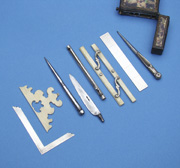 |
 |
|
MINIATURE SILVER DRAFTING SET, German, 18th century, contained in a 3-1/8" x 1-5/8" x 1/2" (8 x 4 x 1 cm) rectangular case bound in leather with gilt-stamped borders throughout and covered with panels of special marbled paper. It is labeled "H." The interior has fittings of silver, and contains: silver square with shaped ends, silver rule of 50 parts with transversal readout to 0.1 parts, elegant parallel rule of silver and ivory, dividers with steel tips, retractable pencil lead holder of silver, steel pricker serving also as handle for steel knife blade, and a wonderfully shaped ivory level designed for plumb bob. One tiny slot is empty, and one leg of the dividers is broken. Otherwise condition is very fine to excellent. The lovely paper panels on the case are interesting. Sometimes called "agate marbled," they are not strictly marbled papers (where colors are floated on water and transferred to paper), but rather "sprenkelpapier" (with colors applied directly to the paper in a special sequence). It was used particularly in Germany and France in the 18th and 19th centuries. A remarkable, elegant miniature outfit, unlike any other we have seen. (10345) $4800. |
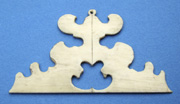 |
| By the English Master Innovator and Craftsman | Click on any image for a larger view. Scroll to view more items. |
 |
 |
 |
|
RARE CULPEPER DRAFTING INSTRUMENT, English, c. 1700, signed "E. Culpeper Londini Fecit." This 6-3/16" (16 cm) long instrument is basically a 0° - 180° - 0° protractor (divided every degree), but of a most unusual execution whereby the first and last 13° are ruled onto extension "ears" forming a straight edge. Also the central vertical support is offset so that one edge aligns with the protractor center and the 90° mark. Condition is good, noting light wear and one hairline crack. We have had two other Culpeper protractors, one brass (Tesseract Catalogue 40 Item 39), the other silver (88/27). Both were simple semicircles with no ears. (10335) $2250. |
| The Outstanding Quality of Lusuerg | Click on any image for a larger view. Scroll to view more items. |
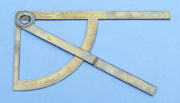 |
 |
|
FINE ITALIAN PROTRACTOR / RULE, 1738, signed "Dominicus Lusuerg F. 1738." Measuring 6-3/4" x 3-1/2" (17 x 9 cm), it is beautifully divided and engraved on both sides with linear scales of "Semipalmus Romanus" (half the Roman palm, divided in inches from -10 to +50 tenths, with one inch being subdivided in twentieths) and of "Semipes Lundinus" (half the London foot, running from 0 to 6 inches with one subdivided to twenty-fourths). There is a fine quadrant scale divided every half-degree, serving as protractor with an encompassing alidade which forms a drafting square when open. Condition is excellent. The instrument is beautifully and thoughtfully crafted, as typical of the works of the Lusuerg family of makers. A similar protractor / rule by Dominicus is present in the magnificent three-level Lusuerg set from the Medici collections, now in the Museo Galileo in Florence. (10315) $5800. |
| Successors to Ramsden's Enterprise | Click on any image for a larger view. Scroll to view more items. |
|
Ramsden's will left the bulk of his estate to his son John, and significant sums to various colleagues and friends. But the tools and stock, and the lease of his house and workshops (at 199 Picccadilly), were bequeathed to Matthew Berge, who continued the enterprise, albeit on a smaller scale, until his death in 1819. Nathaniel Worthington (Berge's only registered apprentice -- McConnell p.266) and James Allan junior (who had worked as Ramsden's shopman and later as Berge's) continued the practice in partnership until c. 1832, then Worthington alone until c. 1852. |
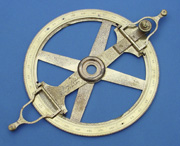 |
 |
|
GEARED FULL CIRCLE MARKING PROTRACTOR, English, early 19th century, finely engraved "Berge, London, late Ramsden." The 6-1/4" (16 cm) diameter circle has an external ring gear, and is divided directly on the brass every half-degree from 0° to 180° twice. A pinion gear, turned by thumbscrew, engages the teeth and rotates the index arm with its one arcminute vernier (center zero) and two swing-out spring-loaded marking pin arms. There is a central precision glass target. Condition is fine noting areas of tiny spotting to the lacquer. As a product of the Ramsden / Berge workshop, this full circle was surely divided on Ramsden's engine, which the Board of Longitude transferred to Berge (this Ramsden's second circular dividing engine, the 45" diameter one, which was completed in 1774 and replaced the 30" diameter first engine). (8466) $895. |
| The Inheritor of Innovation | Click on any image for a larger view. Scroll to view more items. |
|
Thomas Jones (1775 - 1852) is well known as former apprentice,
employee, and perhaps preferable (in our opinion) successor to Jesse Ramsden.
His manufactures are innovative, functional designs, of high quality execution.
Jones finally received Ramsdenıs straight line dividing engine in 1820.
|
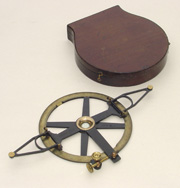 |
 |
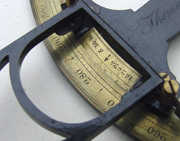 |
|
FINE MARKING PROTRACTOR, English, c. 1830, signed "Thomas Jones, Charing Cross, London" and "HO 5" with the broad arrow mark, on the instrument, "6 in. Protractor, Jones, London" on an ivory plaque inset into the case, and bearing later "Cary & Co." and "Clarkso''s" trade labels in the case. The 6" (15 cm) diameter instrument is made of chemically darkened brass with bright lacquered brass fittings. The scale is divided directly on un-lacquered brass every half-degree from 0° to 360°. Twin verniers read to one arcminute, and there is a central scribed glass target. The design, which seems characteristic of Thomas Jones, has no gearing but rather a smoothly rotatable "index arm" with its verniers, twin foldout spring-loaded marking arms, and clamp and tangent screw slow motion permitting very precise alignments. Condition is fine throughout, complete with its finely shaped fitted mahogany case. It was apparently ordered by the Hydrographic Office, with its cleverly placed ivory identification plaque. (8516) $1250. |
| Parisian Quality for the Draftsperson | Click on any image for a larger view. Scroll to view more items. |
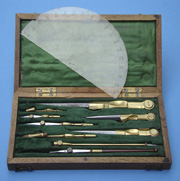 |
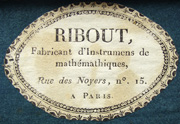 |
|
GOOD FRENCH DRAFTING SET, c. second quarter 19th century, signed on the trade label "Ribout, Fabricant d'Instrumens de mathématiques, Rue des Noyers, no. 15, à Paris." The 4-1/4" x 8" (11 x 20 cm) walnut box is fitted in green velvet and silk, and contains a good set of instruments of brass, steel, and mahogany. There are large and small dividers, each with interchangeable straight steel tip, articulated adjustable ink holder, and articulated pencil holder. The larger one has a long extension arm, for drawing circles and arcs with radii up to 15"! There is also a straight ink pen, and a transparent horn protractor hand-engraved and divided to half-degrees. All is original and in very fine condition, noting slight lid warping, one small item missing (pencil leads, perhaps), and just a little nibbling to the horn. We have had one other instrument by Ribout, that a fine pair of architect's rules (Tesseract Catalogue 24 Item 42). (10235) $1450. |
| London Made, for the American Trade, mid-19th c. | Click on any image for a larger view. Scroll to view more items. |
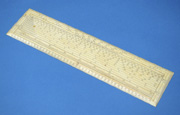 |
|
IMPRESSIVE ARCHITECT'S RULE / PROTRACTOR, English / American, c. mid-19th century, signed "London Made for McAllister Bro's, Philadelphia." Made from a magnificent, large and stable panel of ivory, 12" x 3" (30 x 7.5 cm), the rule has beveled edges divided with a rectangular 180° protractor (every half degree) and with a linear scale of quarter-inches (0-44) subdivided into tenths. A central border surrounds a scale of chords, plus ten scales for plotting reduced and enlarged drawings. The reverse carries another nine linear scales at various reductions, plus one of chords. All is very finely divided, with stamped numerals. Condition is excellent, as new. Apparently extra value was placed on London craftsmanship, so here we have a "London made" rule of exceptional size and quality. Thomas H. and F.W. McAllister were in partnership in Philadelphia until c. 1866 (see Padgitt, 1975, A Short History of the Early American Microscopes). The firm was apparently founded in 1783, and provided all manner of optical and mathematical instruments. (10355) $1450. |
| By Ramsden's "Best" Employee | Click on any image for a larger view. Scroll to view more items. |
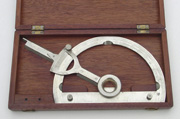 |
 |
|
FINE VERNIER PROTRACTOR IN ELECTRUM, English, second quarter 19th century, signed "Thomas Jones, 62 Charing Crofs, London." This very well constructed semicircular protractor is 6-1/2" (16.5 cm) in diameter, with scale finely divided every half-degree from 0° (and 180°) to 180° (and 360°). A 6-1/8" long index arm moves by ingenious hidden rotation about the open center, and features clamp screw, center-zero one-arcminute vernier, and parallel beveled edges on the center line and 5/16" on either side of the centerline. Optional thumbscrews allow use of prick pinpoints to hold the protractor to the paper. Condition is excellent, complete with the original mahogany case Clifton records Thomas Jones at this Charing Cross address in the trade directories from 1816 until 1850. An excellent example of his high quality of design and construction. (8526) $1100. |
| 180 Degrees on the Oval! | Click on any image for a larger view. Scroll to view more items. |
 |
 |
|
UNUSUAL OVAL PROTRACTOR / RULE FOR THE SURVEYOR, English, c. mid-19th century, the 6-5/8" (17 cm) wide brass instrument divided with three linear scales ("Chains" 0ħ40 divided by quarters, "Acres" 0-40 by ones, and units 0ħ870 by tens), and with fine oval "semicircle" (0-180 and back, by degrees). Condition is fine noting a few small irregularities. This is the first such oval instrument we have had, and quite handsome in design. (10245) $495. |
| Patented American Ellipsograph | Click on any image for a larger view. Scroll to view more items. |
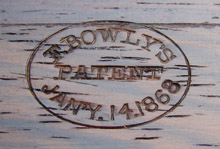 |
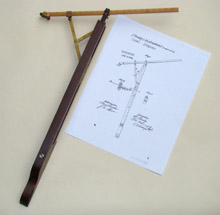 |
|
RARE AMERICAN ELLIPSOGRAPH -- F. BOWLYıS INSTRUMENT FOR DESCRIBING ELLIPSES, c. 1870, signed "F. Bowlyıs patent Janıy. 14, 1868." This most unusual instrument is constructed with framework of beautifully grained tropical hardwood, and with linkages and fittings of brass and boxwood. When closed up it measures 16-1/4" (41 cm) long and only 5/8" x 1-7/8" (1.6 x 4.8 cm) in overall cross section. The frame (whose form reminds one of a violin bow) has fixed point and index pointer for orienting and stabilizing on drawing paper, and the linkage terminates in a holder for pencil lead or ink pen (not present). A boxwood rule is graduated in half inches from 1 to 21, each divided in eighths, and has two sliding swivel clamps (for adjusting size and ellipticity) attached to an extending hardwood arm and to a sliding brass linkage respectively. The instrument is totally functional and in excellent condition throughout. This unusual ellipsograph is the invention of Franklin Bowly of Winchester, Virginia. He claimed "The advantages of this instrument are, great simplicity of arrangement, expedition and convenience in its application, and accuracy with which it describes an ellipse of any desired proportions within wide limits of size, ..," and in 1868 he was granted U.S. patent 73,290. Bowly recommended the instrument for draftsmen in general, using pen or pencil point, but also to cut glass for pictures frames, etc., using a diamond point! Period literature acknowledged the invention, e.g., in Knight's American Mechanical Dictionary (1876). A beautiful example of this clever design, and the only one we have seen. (9273) $5950. |
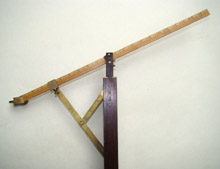 |
 |
| Bearing a Significant Trade Card | Click on any image for a larger view. Scroll to view more items. |
 |
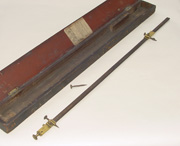 |
 |
|
BEAM COMPASS OUTFIT, English, c. 1833, with the trade label of "Thomas Jones & Sons (Pupil of Ramsden), Astronomical and Philosophical Instrument Makers to His Majesty and the Hon'ble. Board of Ordnance, 62 Charing Crofs, London." Measuring 28" (71 cm) overall (minimum), the compass has a long shaped beam of mahogany reinforced with inset strips of a lighter wood on each side. There are two lacquered brass carriers, one sliding and clampable, the other fixed but with fine screw motion of 1" travel over a brass bearing plate. Two steel points and one ink pen are interchangeable in the carriers. In use one can set off distances, or draw arcs or circles, of distances or radii ranging from 3/4" to 25". Condition is good, lacking one thumbscrew and with some oxidation to the steel tips. The original softwood case shows some wear and soiling. Thomas Jones apparently partnered with his sons for four years only, from 1831 - 1835. Here we have a rare example of that trade card, with his proud "Pupil of Ramsden" proclamation, and an uncommon example of a finely crafted drawing instrument by this maker. (8566) $1450. |
| Three Columns in a Substantial Drafting Tool | Click on any image for a larger view. Scroll to view more items. |
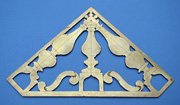 |
 |
|
EXTRAORDINARY ARCHITECHTONIC TRIANGLE / LEVEL, probably English, 18th century. Measuring 7-1/16" (18 cm) along each of the orthogonal sides, this substantial brass square is pierced and engraved, on both sides, with three shaped columns and with twin scroll supporters. At the base of each column is an opening usable for plumb bob, hung by string from a hole at the intersection of the three column centerlines. The long side of the triangle is truncated, giving leveling bases for each of the plumb line positions. Condition is very fine, noting some spotting to the reverse. A lovely tool for the architect or draftsman, the only one of this form we have seen. (10295) $2950. |
| Rolling Rules by the Dozen | Click on any image for a larger view. Scroll to view more items. |
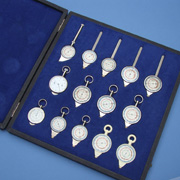 |
 |
 |
|
OPISOMETERS TO CHOOSE FROM, German, c. mid-20th c., the 12-1/2" x 11-3/4" (32 x 30 cm) fabric-covered fitted wood case containing a salesman's full diversity of 14 opisometers. Most have plated brass handles and mounts, and colored paper dials (recording Inches to Miles or Centimeters to Kilometers, or Nautical Miles, or Russian Verstes, etc.), and are two-sided. Each has a small rolling wheel geared to the hand(s), in order to measure, and convert, distances on a chart or graph. Some are combined with magnetic compasses, two have plastic cases (signed "Atlas"), two have calibrated wheels driving multiple hands, etc. Condition throughout is as new. A rare opportunity to acquire this complete collection / physical documentation. (10325) $1600./the set |
| A Pleasure to Handle and to Use | Click on any image for a larger view. Scroll to view more items. |
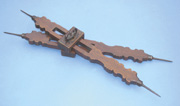 |
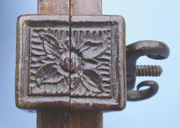 |
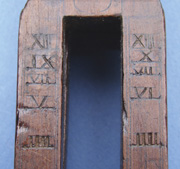 |
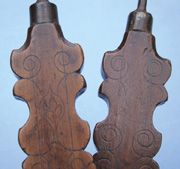 |
|
ELEGANTLY CARVED PROPORTIONAL DIVIDERS, probably central European, c. 17th / 18th century. Measuring 15-1/2" (39 cm) long, the double-ended dividers are masterfully carved of wood with four inset iron tips and a beautiful iron wing nut. Rectangular slots accommodate the sliding, clampable pivot giving variable ratio positions, calibrated with Roman numerals 2 through 10 and beyond (to 16 apparently). The pivot clamp is made of opposing wood blocks, beautifully carved with geometric designs on all sides. The arms are handsomely shaped, their outer surfaces scratch-engraved with symmetrical swirling designs. Condition is very fine throughout. In use, these dividers permit a continuum of ratios from enlargement of 2.1 times, down to 1:1 transfers, to reductions of just under 50%. The scales do not give direct linear ratios, but may relate to polygons inscribed in circles, etc. A most elegant instrument with its finely crafted "folk art" quality. (10281) $4950. |
| A Comprehensive Outfit, with Sterling Features | Click on any image for a larger view. Scroll to view more items. |
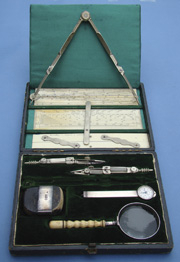 |
 |
 |
 |
|
UNUSUAL DRAFTING COMPENDIUM, English, 1904, signed "Negretti & Zambra * London" on the three mathematical rules, on the largest drawing instrument, and in the case, and silver hallmarked on three instruments, and stamped on the case "A.J.D." for the owner. This complete set is contained in the 7" x 5-1/2" x 1-1/4" (18 x 14 x 3 cm) fitted wood case lined in green velvet and green satin, and bound in dark green grain-patterned polished leather. There is an English-pattern ivory sector with its standard multitude of mathematical scales, a rectangular ivory protractor with numerous architects' and surveyors' linear reduction scales on both sides, an ivory parallel rule with twin hinges of nickel silver, three adjustable drawing compasses in nickel silver, a large eraser bound in sterling silver holder, a magnifying glass bound in sterling silver with a fine turned bone handle (both hallmarked for 1904 London sterling), and an opisometer (labeled Rota-Meter) in a sterling silver mount (hallmarked for 1904 Birmingham sterling) with two-handed dial (feet and inches) and extendible lead pencil. Condition is very fine noting edge wear to the case. This compendium set is quite unusual for its complement of instruments. Perhaps a special order, although to include in a drafting set an opisometer, a lead pencil, a large eraser, and a magnifying glass, all seems eminently sensible. The Negretti and Zambra firm was in business from 1850 until well into the 20th c., manufacturing and selling a very wide range of scientific instruments, with several premises in central London. Their late 19th c. general descriptive catalogue, for example, runs to 577 pages. It offers 23 different forms and sizes of drafting sets, and proposes "Sets of Mathematical Drawing Instruments in Solid Silver made to order." (9259) $3500. |
| "Architect's Foot" Measure in 18th c. Italy | Click on any image for a larger view. Scroll to view more items. |
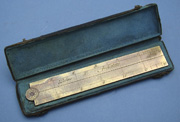 |
|
FOLDING "PALMO DI ARCHITTETTO," Italian, 18th century. Constructed as a sector, the brass rule opens to 8-13/16" (22 cm). The circular hinge is engraved with a rosette on each side, and there is a central stabilizing strip. The front is labeled "Palmo di Archittetto," and this "architectıs foot" of 12 short inches is divided and labeled every inch, the terminal inches divided into tenths and quarters respectively. Each inch is approximately 18.6 mm long. Condition is very fine, with traces of silvering, perhaps, and complete with the original wood case bound in dark leather and lined in green chamois. We find very little reference to the terminology on this rule but, for example, Baldassarre Orsini writes of this scale in his Della Geometrie e Prospettiva in 1771. Most unusual. (9209) $1450. |
| Large Sopisticated Drawing Outfit, with Innovative Devices | Click on any image for a larger view. Scroll to view more items. |
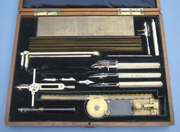 |
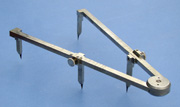 |
 |
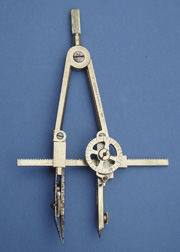 |
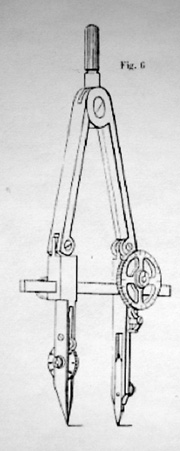 |
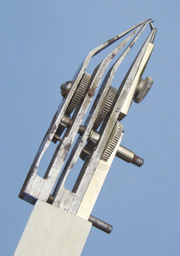 |
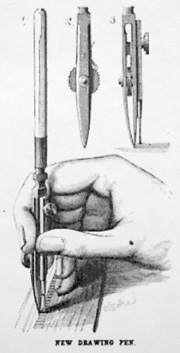 |
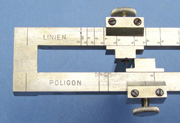 |
 |
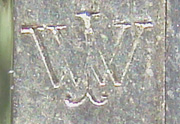 |
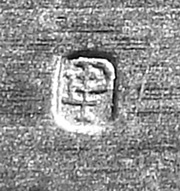 |
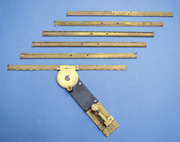 |
|
EXTRAORDINARY DRAFTING COMPENDIUM, Austrian, c. 1880, signed in various places "Pat. Wissmann & Wallegg" and stamped with logos. The fine fitted mahogany case measures 13-5/8" x 10-1/2" x 1-7/8" (35 x 27 x 5 cm), lined in dark blue velvet and satin, containing 19 sophisticated drafting tools and accessories constructed of brass (both lacquered and plated), steel, ivory, thermoplastic, and wood. There is a fine four-legged proportional dividers designed like a Mordente compass, a parallel-leg inking compass with calibrated thumbwheel adjustments of line thickness and radius, a remarkable double-line ruling pen with adjustments by four thumbwheels, adjustable ruling pen with guide, adjustable ruling pen, small ink compass with three thumbwheel settings, three screw-in tips, extending pencil lead holder, tension adjusting tool, rectangular 1:1000 architect's scale with transversal divisions, and finally an adjustable assembly which supports any one of a total of six 10" (25 cm) long interchangeable rules notched with different spacings or cut with waveform patterns, etc., and clampable over a calibrated 180° range of angles. The latter device has a calibrated advance button and serves, among other applications, as a sophisticated section liner producing various types of spaced parallel lines at selected angles, even variously dotted lines using the offset drawing pens. Overall condition is fine, noting surface rust spotting to the steel, two instruments missing, and the case lid slightly warped. These sophisticated drawing instruments are the product of Albert Wissmann and Franz Wallegg, in patnership in Vienna, Austria, and Frankfurt, Germany. They are described in various technical engineering journals c. 1880, and covered by patent protection (including 1879 UK patent for "A hatching apparatus"). The large instrument would seem to be a particularly early (and complex) form of section liner. Extremely rare, it does not feature in David Riches' recent comprehensive article on such instruments (Bulletin of the Scientific Instrument Society, No. 120, 28-34). Clearly very few such compendia have survived, noting one in a Bern, Switzerland museum. (9219) $6500. |
| Attractive Angular/Radial Chart Rule | Click on any image for a larger view. Scroll to view more items. |
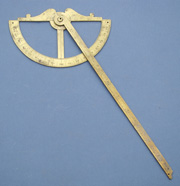 |
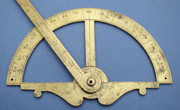 |
|
EARLY LONG-ARM PLOTTING PROTRACTOR, probably German, 17th / 18th century. This finely crafted brass semicircular protractor is 4-1/8" (10.5 cm) wide, with 0-90-0 scale divided every degree and punch-numbered every 10. The crossbar is beautifully shaped and supports a 7-3/4" (20 cm) long rotating arm which is calibrated linearly every unit from 0 to 112 at its shaped far end. The protractor's center is pierced for alignment or fixation, and the instrument has three other fixation holes. Condition is fine noting little traces of gilding. An uncommon early form, with its long plotting arm and elegant shaping. (10291) $1950. |
| Surveying Tools on the Desktop | Click on any image for a larger view. Scroll to view more items. |
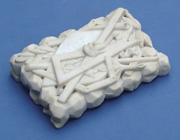 |
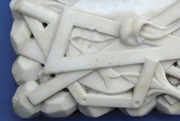 |
|
SURVEYORıS OR DRAFTSMANıS PAPER WEIGHT, c. 19th century, measuring 5-5/8" x 3-5/8" x 1-1/2" (14 x 9 x 4 cm), the white stone carved as a rocky field with vines, topped with a multi-fold graduated rule, a right triangle, a rod, a ribbon, and a roll of paper. Unusual, and in fine condition, perfect for the professional's or collector's desk. (10223) $850. |
| Signed Dividers from the South of France | Click on any image for a larger view. Scroll to view more items. |
 |
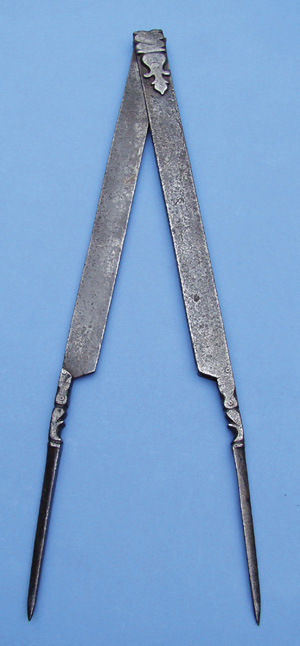 |
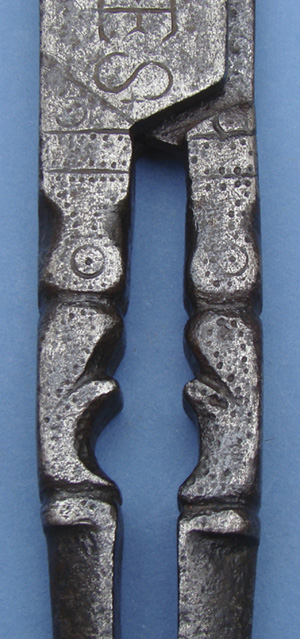 |
|
LARGE WROUGHT-IRON DIVIDERS, French, 18th century, boldly
signed "IEAN BAPTISTE LASCOVRREIGES" (charmingly engraved with
the "N" backwards and the "G" upside down). This finely
hand-wrought carpenter's or shipbuilder's dividers are 20-3/4" (53
cm) tall, with fleur-de-lys on both sides of the hinge, and serpentine
or floral shapes with pointillated decor on all four sides, near the tapered
points. Condition is fine noting general old pitting. Jean Baptiste is
a common French name (noting 43,700,000 hits on a recent Google search),
but the place Las Courreiges (Las Courrèges today) is little known. But
we do find that name used for several roads, and one significant dwelling,
all in the south of France near Toulouse. (9216) $1450.
|
| A Particularly Early, Diminutive Pantograph | Click on any image for a larger view. Scroll to view more items. |
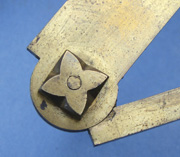 |
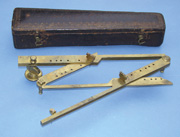 |
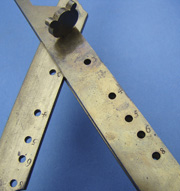 |
 |
|
EARLY CONTINENTAL PANTOGRAPH, c. early 18th century. This diminutive drafting instrument is contained in its original finely shaped and fitted wood case bound in dark leather with gilt-stamped decoration to the lid, the interior lined with red chamois leather, the case 10-5/8" (27 cm) long overall. The brass pantograph is substantially built, designed with opposed hinged "V" shapes which join in widely-adjustable integral positions (*, 3, 4, 5, 6, 8) on each of the four arms. The larger "V" has one polished steel foot (which rests at a fixed point established by a hole in the fitting which screws into the wood of a drafting table), a brass foot which slides on the table, and a sharp tracer point to follow a drawing or chart. The smaller "V" rides along, with a pencil holder at its apex, making a reduced or enlarged copy. The brass nuts and thumb pins are all crafted in lovely early decorative shapes. Condition is very fine and complete noting minor stains to the brass and some wear to the case. Hambly traces the origin of the pantograph to a wood parallelogram design giving a 1:2 reduction, as published by Christoph Scheiner in 1631. Later versions with adjustable intersections gave a choice of alternative reduction ratios. By the mid-18th century the pantograph became very popular in England, especially in brass, and was produced by all the major instrument makers. It was less common in France, although high quality ones with arms of ebony are encountered. Here we have a very rare and probably very early example from the Continent. (10252) $4500. |
| By Thomas Heath, with Ingenious Single-Transversal Readout | Click on any image for a larger view. Scroll to view more items. |
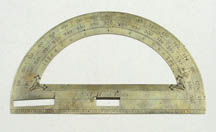 |
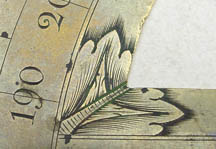 |
 |
|
SPLENDID PROTRACTOR BY THOMAS HEATH WITH FIVE - ARCMINUTE TRANSVERSAL WINDOW, English, c.1725, signed "T:Heath Fecit." The 8" diameter (20 cm) semicircular brass protractor is hand-divided every degree, with beautiful bold numbering every 10° from 0° to 180° (and from 180° to 360°). The left side is pierced with a window and transversal running from 0° to 1°, itself divided every five arcminutes from 0 to 60. It is further pierced with a central rectangle, and decorated with bold elegant hand engraved "leaves" in the corners. Scales of polygon angles (from 4-sided to 12-sided) are laid out against the degree scales (from 90° down to 30° and up to 150°), and the base of the protractor is finely divided with a scale of four parts per inch, each part subdivided to tenths. Condition is generally fine throughout, noting minor signs of use. Heath was an exceptional maker, but instruments by him appear infrequently on the market. This one is remarkable in its use of a transversal window, a feature we have seen rarely, once by Edmund Culpeper, and again by Heath (see Millburn's article SIS Bulletin 50, pp. 25-26). In use one measures an angle by placing the protractor's centerpoint on the angle's vertex, placing the crossbar more or less along the baseline (the first side of the angle) rotating the protractor slightly (less than 1°) until the second side exactly cuts an integral number of degrees (or half degrees), and reads the additional minutes where the transversal cuts the baseline. It is a practical, fast technique for reading (or marking) headings, etc. to five arcminutes or better. (7264) $3500. |
| Sumptuously Decorated Architect's Tools | Click on any image for a larger view. Scroll to view more items. |
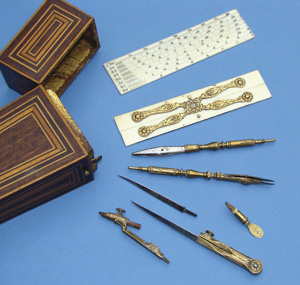 |
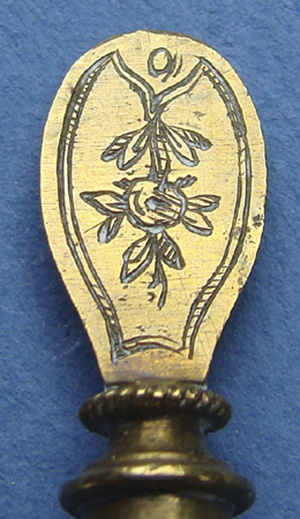 |
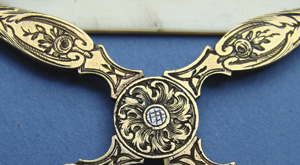 |
|
EXTRAORDINARY PART-SET OF DRAWING INSTRUMENTS, probably English, c. 1830, the brass tools with the most sumptuous decoration throughout. There are eleven slots in the case, of which eight are filled, as follows: -- brass and steel dividers body, -- steel tip to complete the above as 3-13/16" (10 cm) tall dividers, -- elegantly shaped brass tip to complete the above as pencil compass, -- hand-held brass pencil holder, -- vertical pen with spring-loaded steel-tipped brass blades for inking; it separates to reveal scriber point on the handle, -- vertical pen with curved steel blades for inking; it separates to reveal scriber point on the handle, -- magnificent little ivory parallel rule with golden scissors hinge bearing extensive floral decor, -- unusual ivory draftsmanıs rule with seven different reduction scales of equal parts, a scale of chords, and on the reverse scales of half- and quarter-inches with transversal interpolation grids. All of the brass surfaces are skillfully hand engraved with floral and geometric designs. The set is housed in a remarkable portable wooden case 5-1/2" (14 cm) tall, the exterior covered in rectangular and trapezoidal concentric patterns of inlays of different woods, almost as an early "op-art" or "perspective" box, the interior retaining some gilding to the wood. The effect is reminiscent of Tunbridge ware. Condition is very fine, noting one tiny chip to the wood, and the obvious missing pieces to the set. A remarkable set, for which we find no comparable example. (9236) $6500. |
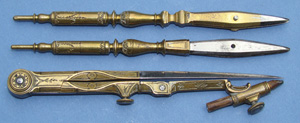 |
| Handmade in Burgundy | Click on any image for a larger view. Scroll to view more items. |
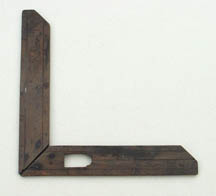 |
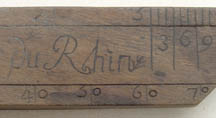 |
|
HAND CARVED FOLDING SQUARE / LEVEL / RULE, French, late 17th / early 18th c. This wooden "square" has hinged 6-3/8" (16 cm) legs, one pierced and notched for plumb bob and string. The legs are boldly cut with scales of Rhine inches ("Pouces du Rhin"), and of Kings inches ("Pouces de Roy") from 0 to 6 with subdivisions to twelfths, and with two further linear scales running 0 - 70 and 0 - 80 respectively. Condition is good noting slight wobble to the hinge. One leg is engraved "A autun," perhaps a clue to its maker, the city of Autun lying on the Saône-et-Loire in Burgundy. The first wooden example of this instrument we have seen. (7284) $495. |
| Engraved Dividers 38cm Tall | Click on any image for a larger view. Scroll to view more items. |
 |
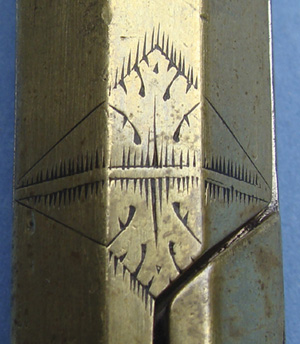 |
|
MAJOR EIGHTEENTH CENTURY DIVIDERS, probably French, c.
first half 18th century. Measuring a full 15-1/8" (38 cm) tall, they
are constructed wth a brass body, eight sided "pommel" head,
smoothly-acting five-leaf brass and steel hinge, and tapered steel tips,
one removeable. The brass shoulders have delicate shaping, and there is
fine decorative geometric engraving on four sides of the pommel, and around
the lower end of the hingework. Condition is fine noting light spotting.
A major pair of precision dividers, remarkable for their size and beauty.
(9276) $2950.
|
 |
| Invented by the Renowned Engineer and Surveyor of the Pennsylvania Coal Mines | Click on any image for a larger view. Scroll to view more items. |
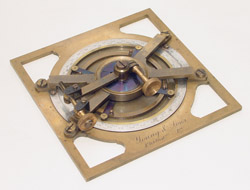 |
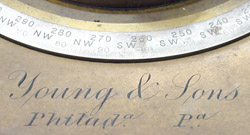 |
|
KIMBER CLEAVER'S MARKING PROTRACTOR, American, boldly signed "Young & Sons, Philada., Pa." This very substantial instrument is made of brass, 6-1/2" x 6-5/8" (16.5 x 17 cm), with distinctive X-form superstructure carrying the 5" diameter divided circle, clamp and long tangent screw. The circle has a silver degree scale divided every half-degree and labeled with directional headings (e.g., SW 210°). The circle is mounted with four knobs for rotation and four spring-loaded marking pins. Rotation is very smooth and sure. There is an external one-arcminute vernier in silver. Condition is very fine, the brass darkening a bit. The instrument is quite handsome with its distinctive design and combination of finishes (clear lacquered and chemically darkened brass, blued steel springs, and silver scales). We note a smaller example of this rare instrument in Tesseract Catalogue 70 Item 26. Kimber Cleaver (1814 - 1858) started out as a teacher, but quickly rose to become the great mining engineer of the anthracite coal regions of Pennsylvania. He developed various mining inventions, and his innovative protractor, but held no patents, preferring to benefit the common good. Cleaver is credited with the original idea of laying the Atlantic cable. His mother is recorded as a Quaker, but he allied himself with the Native American political party, eventually running for Governor on that ticket. The maker is the famous firm established by William J. Young (born Scotland 1800, died Philadelphia 1870). In 1813 he was apprenticed to Thomas Whitney, and went on to become America's foremost surveying instrument maker of the mid-19th century. The rugged precision construction of this device is quite like that on his examples of Burt's solar compass, and in fact on his production of Burt's solar sextant (see Tesseract Catalogue 43 Item 28). (9261) $2950. |
| Victorian Full-Circle Protractor, c. 1862 | Click on any image for a larger view. Scroll to view more items. |
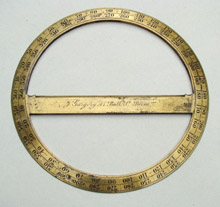 |
 |
|
FINE VICTORIAN BRASS PROTRACTOR, English, c. 1862, signed "J. Gargory, 41 Bull St., Birm'm." This 6-1/4" (16 cm) diameter full-circle protractor is divided every degree from 0° to 360°, and back again, boldly labeled with easy to read numerals. Both crossbar and circumferential edge are beveled down to the surface of map or chart. Condition is fine, retaining much of its original lacquer finish. James Gargory is listed as optician, jeweler, goldsmith, and mathematical, mining, surveying, and optical instrument maker. Clifton gives working dates of 1835 - 1862, always on Bull Street in Birmingham, but at the present address only in 1862. (9305) SOLD |
| Good French Ironwork | Click on any image for a larger view. Scroll to view more items. |
 |
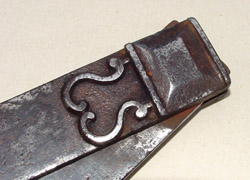 |
|
FINE IRON OUTSIDE CALIPERS, French, 18th century, measuring 21-1/2² (55 cm) tall, they feature long three-leaf hinge plates with finely shaped recurved decoration leading to the inward-facing tapered four-sided points. The hinge plates form a full right angle builderıs square, when open to a scribe mark on the hinge. The hinge itself has beveled rectangle decoration leading to double-S supporters. In fine condition, a wonderful example of early outside calipers, for builderıs and / or gunnerıs use. (7276) $2950. |
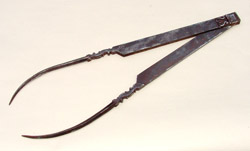 |
| Swiveling Set of Large Boxwood Architect's Rules | Click on any image for a larger view. Scroll to view more items. |
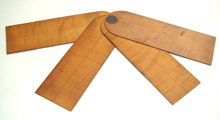 |
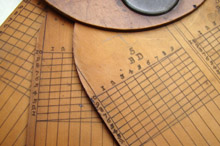 |
|
REMARKABLE BOXWOOD DRAFTING RULES, English, c. 18th century, the four double-sided rules cut as single panes of boxwood measuring an extraordinary 3-5/8" x 11-3/8" (9 x 29 cm), and mounted as a swiveling set with brass hinge. Each face (except the backside of the bottom one), is divided with two sets of linear reduction scales with transversal interpolation to the one-hundredth part of one unit. Each scale is identified with a "5" and with a two-letter code (AD through AI, BK, BA through BG). Two scales have old hand-written ink labels "63 (68) to an inch." Condition is very fine throughout except for a number of stains just on the outer surfaces of the set. This is the first such set of early drafting rules we have seen. They would be used with dividers to lay out, or read out, distances on scale drawings, with a choice of 14 scales. A century later one would find cased sets of individual rules, and made not of boxwood but of ivory or ivorine. (9253) $1650. |
| Scales for Official French Mapping, c. 1800 | Click on any image for a larger view. Scroll to view more items. |
 |
 |
|
IMPORTANT HIGH-PRECISION CHART RULE, French, c. 1800, signed "Ferat a Paris; Depot G'al. de la Guerre 81." This heavy gilt brass rule, 8-3/4" x 2-3/4" (22 x 7 cm), is exquisitely engraved on both sides with reduction scales of equal parts, the scales numbered 4, 5, 6, and 7. Each scale is linearly divided, with transversal scale at the end subdividing the main divisions down to 1/100 or 1/50 part. Designed for the metric system, they are labeled with the scale reductions and usages, e.g., "Echelle de 2 Millimetres pour 100 Metres (Pour les dites Cartes reduites et a graver)." Besides scales for the engraving of charts, there are ones for use on maps of the "Reconnaissances Militaires," and for the "Canevas de la Topographie" (the baseline grid topographic maps). Divided with high precision, one still sees many of the layout marks, and engraving guidelines. Condition is fine noting some scratches and minor discolorations. It is complete with its original protective card case. This is the first "official" French rule we have had designed for the construction, engraving and readout of military charts. It was part of the War Department's "Depot General" which was charged with furnishing the necessary charts and plans to the armies, as well as training Geographical Engineers. It is further significant in being signed by the maker. Ferat is recorded from 1799 to 1806, relocating frequently, through four different Paris addresses over seven years (see Marcelin). The young Gambey worked for him. The fineness of Ferat's engraving is truly exceptional. (9221) $2800. |
| Early Engraved Ironwork | Click on any image for a larger view. Scroll to view more items. |
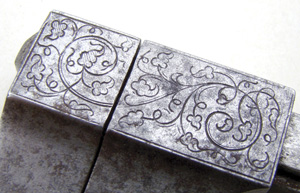 |
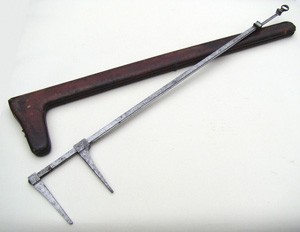 |
|
EXCEPTIONAL PARALLEL-JAW CALIPERS, European, c. 1800,
signed indistinctly "J. Peilland" (or "J. Peillaud").
These fine worked-steel calipers open by finger pull from 26-7/8"
to 49-3/4" (68 to 126 cm). The 4" long jaws thus extend from
direct contact to 22-3/4" (58 cm) separation, which is measured by
graduations on both sides of the extended central pull shaft. Both sides
are divided every half centimeter, apparently, from 0 to 50. The jaws
are precisely fashioned, and their movement is quite parallel with the
pull rod riding in a long slot. The finger hold and finger pull are well
shaped for aesthetics and function, and the jaw heads are beautifully
engraved in the steel with graceful floral patterns that join up when
the jaws are in contact. Condition is fine noting general spotting.
The original shaped and fitted wood case is present, adding a wonderful appeal to the instrument. The case is bound in red Morocco leather, and lined in chamois leather; it is in generally good condition noting stains and loss of the closure hooks. A fine instrument, provenanced to the Rullier collection. (9266) $3950. |
| Defensive Dividers! | Click on any image for a larger view. Scroll to view more items. |
| Measuring by the Foot of the King | Click on any image for a larger view. Scroll to view more items. |
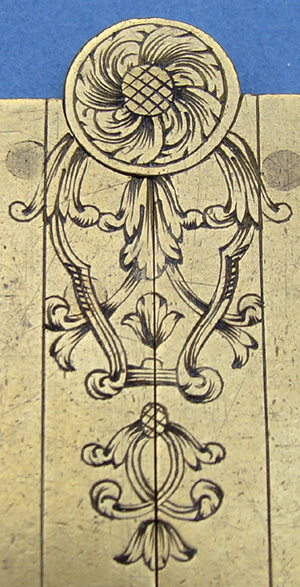 |
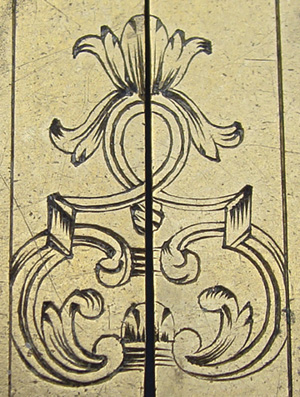 |
|
EXQUISITE "HALF THE KINGıS FOOT" RULE, French, mid-18th century, signed "Duhamel à Paris." This folding brass rule opens to 6-7/16" (16 cm), and is divided on one side with a "Demy Pied De Roy" scale of six early French inches ("pouces"), the terminal inches divided into twelfths of an inch ("Lignes"). Both sides bear the most elegant symmetrical patterns of hand engraving. A lovely rule, in very fine condition, by Jean-Jacques Duhamel father or son.(9306) $1650. |
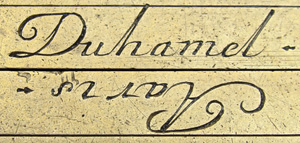 |
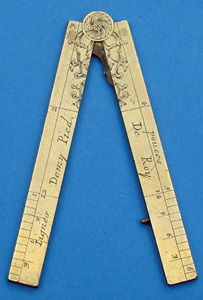 |
| Astronomy |
| Microscopy |
| Dialling |
| Navigation |
| Demonstration & Experimentation |
| Calculation |
| Medical |
| Specials |
| Books New and Old |
| Tesseract Catalogues |